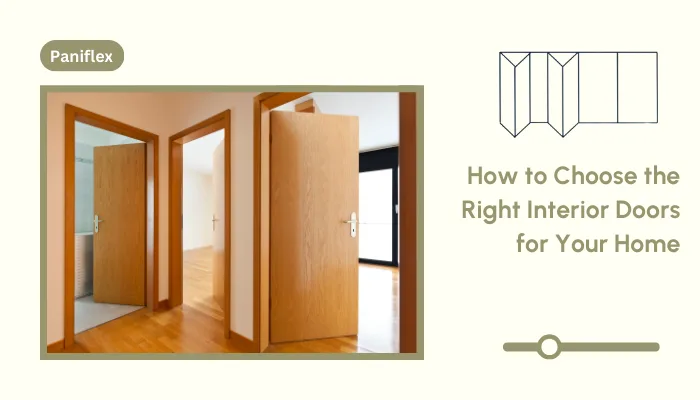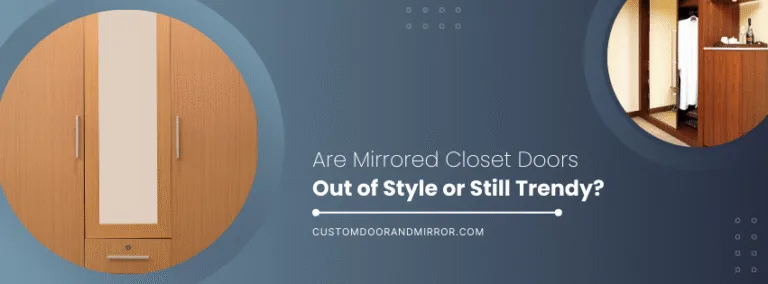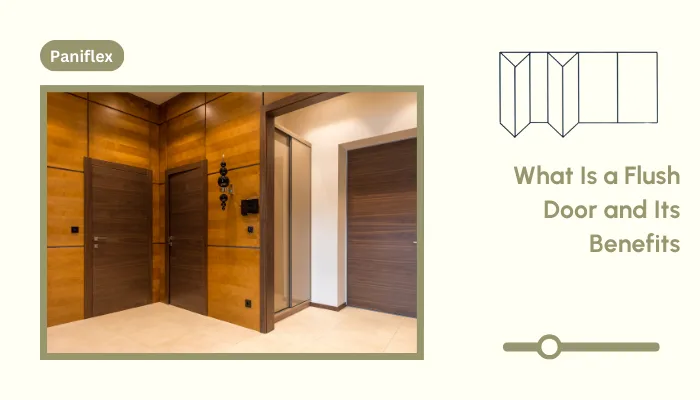Interior doors do more than divide spaces. They influence design flow, privacy, acoustics, and even how natural light moves through a home. Selecting the right door is crucial for creating a pleasing interior. We understand the challenges of balancing performance and client expectations on residential projects.
The wrong choice often leads to callbacks, rework, and long-term maintenance issues. This guide helps you evaluate key factors and other considerations so your next project delivers doors that perform and impress.
Ready to experience the benefits of custom closet doors? Explore our range of Paniflex products now.
At a glance:
- Select interior doors by considering the material, design, room function, and long-term durability for each space in your project.
- Consider environmental factors such as humidity, traffic levels, and sound insulation needs when selecting door types.
- Match hardware and finishes carefully to ensure seamless functionality and design cohesion.
- Avoid common mistakes such as poor sealing, ignoring site conditions, and prioritizing design over performance.
Role of Interior Doors in Home Design
Interior doors are not just functional elements. They shape how spaces feel, look, and perform. Every choice affects privacy, light flow, and the overall design appearance.
These are a few ways in which interior doors impact the style and usability of your space:
- Define spaces without sacrificing openness or natural light.
- Contribute to sound control between rooms for better comfort.
- Enhance the design language with materials, colors, and finishes.
- Influence space planning through swing direction and clearance needs.
- Support durability in high-traffic or moisture-prone areas.
To make the right choice, professionals must weigh multiple factors, ranging from materials and styles to performance in specific environments. These are explained in detail in the following section.
Suggested Read: Installing Sliding Closet Doors Over Carpet
Key Factors to Consider When Selecting Interior Doors
Choosing the right interior doors requires more than selecting a style. The right choice requires careful consideration of how materials, style, and client needs work together for lasting results. These are the considerations you need to keep in mind:
1. Material Selection
The material determines how well a door performs in different environments. Solid wood offers timeless beauty but may swell in humid areas. Engineered cores and solid-backed doors provide better stability and moisture resistance, making them ideal for high-use and high-moisture spaces.
2. Style and Design Compatibility
Doors should complement the overall design language of a home. Whether it is clean-lined flush doors for modern interiors or paneled designs for traditional spaces, the style must align with the project’s design goals and the client’s expectations.
3. Acoustic and Privacy Considerations
Solid-core or solid-backed doors are essential in bedrooms, home offices, and bathrooms where sound insulation and privacy are priorities. Hollow-core doors may be suitable for less critical areas, but they often compromise on noise control.
4. Durability in High-Traffic Areas
For spaces like kitchens, hallways, and mudrooms, durability is key. Factory-applied finishes and moisture-resistant construction help prevent damage from frequent use, temperature shifts, and occasional impacts.
5. Ease of Maintenance
Select materials and finishes that resist scratches, stains, and moisture. Factory-applied coatings often outperform onsite finishes, reducing maintenance needs and ensuring the doors retain their appearance for longer.
Suggested Watch: Watch this video to choose between hollow vs. solid core doors.
Popular Types of Interior Doors

Interior doors come in many styles to meet different design and functional needs. Each type offers unique benefits and challenges for residential projects. Let’s take a closer look at the features and characteristics of the most popular interior door types and how they can benefit your space.
1. Hinged Doors – The Classic Choice
Hinged doors are a timeless and versatile option that works well in a variety of spaces. They offer excellent functionality, ease of use, and come in various styles to match your home’s décor. Consider the following aspects when choosing hinged doors:
- Versatility Across Rooms: Hinged doors are suitable for most spaces, including bedrooms, living rooms, and bathrooms, providing a timeless aesthetic.
- Variety of Designs: From flush to panel designs, hinged doors offer a wide range of styles to complement any décor.
- Space Requirements: Ensure there’s enough swing clearance around the door to allow for smooth operation and prevent obstruction.
2. Sliding Doors – Space-Saving Elegance
Sliding doors are an excellent choice for rooms where space is at a premium. They offer both style and functionality, providing an elegant way to separate spaces while saving floor space. Here are some key features to consider:
- Perfect for Tight Spaces: Sliding doors are ideal for areas like closets, pantries, and small rooms where space is limited.
- Stylish Design Options: Available in various styles, from rustic barn doors to modern track systems, sliding doors bring charm to any room.
- Maximized Floor Space: These doors don’t require extra floor space for swinging open, making them a great choice for compact areas.
3. Pocket Doors – Hidden Functionality
Pocket doors provide a hidden, space-efficient solution for areas where conventional doors would take up too much room. These doors are perfect for creating more usable space in tight layouts. Here’s what makes pocket doors unique:
- Efficient Use of Space: Pocket doors free up valuable floor area by sliding into the wall, making them ideal for small layouts.
- Sleek Design: When open or closed, pocket doors maintain a clean, minimalist look, perfect for modern and contemporary interiors.
- Requires Careful Installation: Planning is essential for the wall construction and hardware installation to ensure seamless operation.
4. Accordion Doors – Practical and Compact
Accordion doors are designed to fit narrow spaces and provide flexible access. They are a practical choice for wide openings, offering ease of use while occupying minimal floor space. Consider these benefits:
- Space-Saving Design: Ideal for closets, laundry rooms, and pantries, accordion doors allow easy access to wide spaces without the need for large swing doors.
- Partial or Full Access: You can open the door halfway or fully, depending on your needs, providing flexibility for various uses.
- Sound Considerations: While convenient, accordion doors are generally less soundproof than traditional hinged doors, so consider their placement carefully.
5. French and Glass Panel Doors – Style with Light Flow
French and glass panel doors are perfect for adding elegance to your home while maximizing natural light flow between rooms. These doors create a sense of openness without sacrificing privacy. When considering these doors, keep in mind the following features:
- Perfect for Light Sharing: These doors are ideal for areas like home offices, dining rooms, or between the kitchen and living area, where light sharing and openness are desired.
- Elegant Separation: They maintain a sense of separation while preserving visibility between rooms, making them perfect for spaces that need both privacy and connection.
- Privacy Glass Options: If you want to balance openness with privacy, options such as frosted or tinted glass can provide the right level of discretion.
Doors might seem straightforward, but there’s more to picking the right one than meets the eye. Before you make your final call, let’s run through some common mistakes to watch out for.
Suggested Read: How to Install Bifold Door Snugger: A Basic Guide
Common Mistakes to Avoid When Selecting a Door
Even experienced professionals can overlook critical factors during door selection. These missteps often lead to functional issues, increased maintenance, and dissatisfied clients. Knowing these pitfalls helps avoid costly rework and ensures project success.
1. Overlooking Environmental Factors
Failing to account for humidity and temperature changes can result in swelling, warping, and sticking doors.
Solution: Choose moisture-resistant materials and ensure doors are appropriately sealed on all edges, especially in kitchens, bathrooms, and laundry areas.
2. Ignoring Hardware Compatibility
Not all hinges, handles, and tracks suit every door type. Poor hardware choices can affect smooth operation and longevity.
Solution: Match high-quality hardware systems to the specific door style and weight for reliable performance.
3. Focusing Only on Looks
Prioritizing style over function may result in doors that look good but fail under daily use. You do not want doors that follow the design of the space but miss out on performance.
Solution: Strike a balance between design, durability, acoustics, and ease of use, especially in high-traffic or sound-sensitive areas.
4. Neglecting Proper Clearances and Acclimatization
Installing doors without considering expansion gaps or site acclimatization leads to alignment issues. This can result in major issues after the installation is complete.
Solution: Allow doors to adjust to site conditions before installation and follow manufacturer guidelines for clearances.
5. Using Inadequate Finishes for High-Moisture Areas
On-site finishes often fail to protect doors from humidity and spills. You need to ensure that you attend to the finishing touches while also considering environmental factors.
Solution: Specify factory-applied finishes for consistent, edge-to-edge moisture protection.
From the Community: Explore this Reddit thread where homeowners and professionals share their experiences updating interior doors.
Tips to Select the Right Door for Each Room

Each room has unique functional and design requirements. Selecting doors based on location ensures better performance, durability, and client satisfaction.
Here are some helpful tips to choose a door based on the space:
- Bathrooms: Use moisture-resistant materials and factory finishes to prevent swelling and warping in humid conditions.
- Bedrooms: Prioritize sound insulation and privacy with solid-core or solid-backed doors.
- Closets: Choose space-saving solutions like sliding or bi-fold doors to maximize room functionality.
- Kitchens and Pantries: Consider durable doors with easy-to-clean finishes for high-traffic, high-moisture environments.
- Laundry Rooms: Install well-sealed, moisture-resistant doors to handle heat and humidity while containing noise.
- Home Offices: Use glass panel or French doors for light flow, combined with sound-reducing cores for acoustic control.
Material and finish choices are just as critical as door placement. These elements determine how well a door resists wear, moisture, and environmental changes over time. This is explained in the following section.
Suggested Read: How to Fix a Large Gap Under the Door?
Why Material and Finish Matter for Long-Term Performance
The right material and finish are essential for doors that stand up to daily use and environmental challenges. Poor choices lead to swelling, warping, and costly replacements. To ensure your door stays functional and looks good for years, check for these key material and finish qualities before making your choice:
- Solid-Backed and Engineered Cores: Offer superior dimensional stability and resist swelling in humid environments.
- Factory-Applied Finishes: Provide uniform, edge-to-edge protection that outperforms onsite painting or staining.
- Sealed Edges: Prevent moisture from penetrating vulnerable areas like door bottoms and hinge sides.
- Scratch and Impact Resistance: High-quality finishes reduce surface damage in high-traffic zones.
- Low Maintenance Needs: Durable materials and coatings minimize upkeep and extend the door’s lifespan.
- Consistency Across Projects: Factory processes ensure every door meets the same performance standards.
While materials and finishes form the foundation of door quality, hardware choices are just as critical for functionality and long-term reliability.
Importance of Interior Door Hardware
Hardware defines how doors function and how users interact with them daily. The right components enhance durability, safety, and design continuity across a project. It can also make the difference between a door that works flawlessly and one that causes ongoing issues.
Here’s what to look for:
- Hinges: High-quality hinges prevent sagging and ensure doors stay aligned over time.
- Handles and Levers: Choose designs that complement door styles and offer ergonomic use for all ages.
- Locks and Privacy Sets: Match locksets to room function—privacy for bathrooms and bedrooms, passage sets for shared spaces.
- Sliding and Pocket Door Systems: Use robust tracks and rollers to avoid sticking or misalignment in high-use areas.
- Closers and Stops: Protect doors and walls from damage in high-traffic zones.
- Finishes and Coatings: Consistent hardware finishes maintain design cohesion throughout the home.
With materials, finishes, and hardware covered, professionals can now focus on guiding clients to interior door choices that balance style, function, and long-term value.
Deliver Better Results With Every Installation
Every project demands doors that perform flawlessly and maintain their appearance for years. Custom Door & Mirror designs custom solutions that address common challenges like swelling, warping, and misalignment, helping professionals deliver reliable results with confidence.
These are a few reasons why interior designers, architects, and contractors trust us for interior doors:
1. Solid Backing for Superior Strength
Our doors feature solid backing construction that resists impacts and prevents moisture penetration. This design creates unmatched dimensional stability, reducing callbacks and maintenance in high-use or high-humidity environments.
2. Patented TruClose Hinges
TruClose hinges keep doors properly aligned even with repeated use. They prevent sagging and sticking, ensuring smooth operation and extending the life of the installation.
3. Factory-Applied Finishes
Every door receives an edge-to-edge finish in a controlled environment. This process seals even hidden areas, delivering superior moisture resistance and a consistent, professional appearance.
4. Moisture-Resistant Engineering
Our doors are built to handle kitchens, bathrooms, and laundry rooms without swelling or warping. This allows designers to maintain design integrity across every room of a project.
5 .Impact Resistance for High-Traffic Areas
Solid backing and reinforced edges help doors stand up to daily use in busy households and commercial spaces. This durability reduces damage and preserves the door’s look for years.
Our doors offer clean lines, tight tolerances, and a range of finish options. This ensures seamless integration into both traditional and modern interiors, supporting your design vision.
With these features, Custom Door & Mirror helps architects, interior designers, and contractors specify doors that meet client expectations and stand up to real-world use.
Ready to experience the benefits of custom closet doors? Explore our range of Paniflex products now.
Conclusion
Choosing the right interior doors is about more than finding the right look. It requires careful consideration of materials, finishes, hardware, and room-specific needs to ensure long-lasting performance and client satisfaction. Minor oversights at the selection stage can lead to costly fixes later.
Custom Door & Mirror offers solutions that help professionals avoid these challenges. With solid backing, TruClose hinges, and factory-applied finishes, our doors are engineered to deliver reliable performance in every installation. Contact us to learn more about our products or request a specification guide for your next project.
Frequently Asked Questions
1. How to choose interior doors for a home?
Consider material, style, functionality, and room-specific needs. Match door designs to your interior theme while ensuring durability, sound control, and moisture resistance for long-term performance in every space.
2. What are the five factors to consider when selecting a door?
Key factors include material choice, design compatibility, sound insulation, moisture resistance, and the quality of the hardware. These elements determine how well interior doors perform and complement your project’s overall look.
3. Should interior doors be darker or lighter than the walls?
It depends on the design intent. Lighter doors create seamless transitions and an airy feel. Darker doors provide contrast, add depth, and can highlight architectural features in modern or traditional interiors.
4. How do I determine which door I need?
Assess each room’s requirements: privacy, sound control, and moisture exposure. Then select appropriate materials, finishes, and hardware that balance function and appearance. Consult manufacturers for specifications that suit your project conditions.






